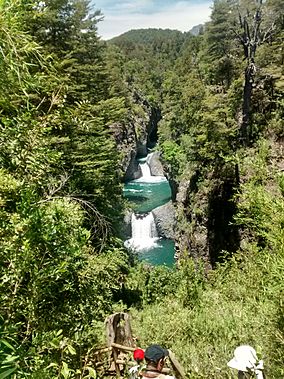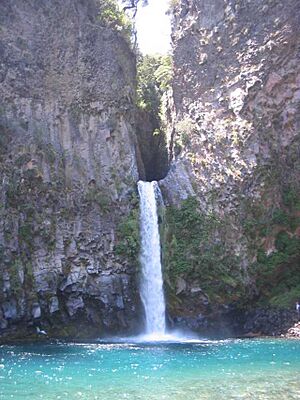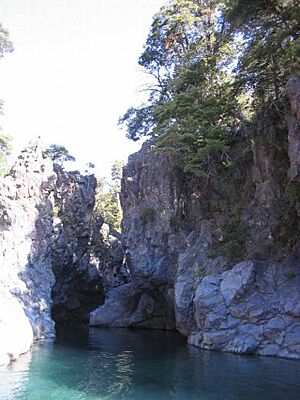Radal Siete Tazas National Park facts for kids
Quick facts for kids Radal Siete Tazas National Park |
|
|---|---|
|
IUCN Category II (National Park)
|
|

The Seven Cups
|
|
| Location | Maule Region, Chile |
| Nearest city | Molina |
| Area | 41.4 km2 (10,200 acres) |
| Governing body | Corporación Nacional Forestal |
Radal Siete Tazas National Park is a beautiful natural area in Chile. It is found in the Maule Region, close to the city of Molina. This park is famous for its amazing waterfalls and unique natural pools. It is a great place to explore nature and see special plants and animals. The park is located in a hilly area near the Descabezado Grande volcano.
Contents
History of Radal Siete Tazas Park
This special natural area became a national park in 2008. Before that, it was a different kind of protected area. National parks are created to protect important natural places.
Changes to the Seven Cups After the 2010 Earthquake
On February 27, 2010, a big earthquake hit Chile. After this earthquake, one of the park's main attractions, the "Seven Cups," completely dried up. Scientists believe a crack in the rocks allowed the water to flow away. The water likely went into an underground water source called an aquifer.
Exploring the Geography of the Park
The most popular part of Radal Siete Tazas National Park is the area called Siete Tazas. This means "Seven Cups" in Spanish. It has seven natural pools, one after another, with waterfalls between them. These pools are along the Claro River. The waterfalls here are different sizes, from 1 to 10.5 meters tall.
Amazing Waterfalls in the Park
Besides the Seven Cups, there are two other impressive waterfalls. They are called El Velo de Novia (The Bridal Veil) and La Leona (The Lioness). El Velo de Novia drops 40 meters straight down. La Leona has a 20-meter drop.
Kayaking Adventures
Many kayakers love to paddle down the smaller waterfalls in the park. These falls range from 1 to 10.5 meters (3 to 32 feet) high. Once kayakers enter the steep canyon, the only way out is to keep going downstream. Tourists often gather on platforms to watch the kayakers bravely go over the waterfalls. At the end of their exciting trip, kayakers must quickly paddle to shore. This is important to avoid the big 40-meter waterfall. After that, they hike out of the canyon.
Park Elevations
The land in Radal Siete Tazas National Park goes from 650 meters (about 2,130 feet) high to 2,600 meters (about 8,530 feet) high. This means there are many different landscapes to see.
Animals and Plants of the Park
The park is home to many interesting plants and animals. It helps protect different types of trees, especially those from the Nothofagus family.
Special Trees in the Park
Some of the important trees found here include the Nothofagus glauca and Nothofagus × leoni, which are threatened. You can also find Nothofagus macrocarpa, Nothofagus dombeyi, Nothofagus antarctica, and Nothofagus alpina. The park also protects rare and vulnerable trees like Austrocedrus chilensis and Maytenus chubutensis.
Endangered Birds
Radal Siete Tazas National Park is a safe place for a special type of burrowing parrot. This parrot is called Tricahue by local people. It is an endangered subspecies, which means it is at risk of disappearing forever. Protecting the park helps these beautiful birds survive.
See also
 In Spanish: Parque nacional Radal Siete Tazas para niños
In Spanish: Parque nacional Radal Siete Tazas para niños



